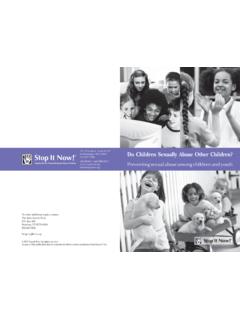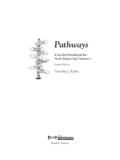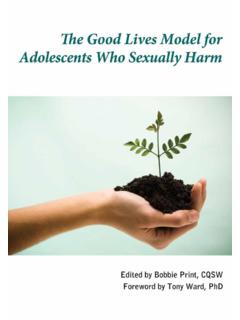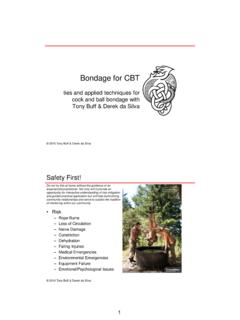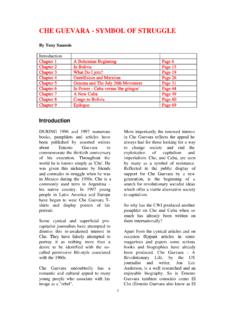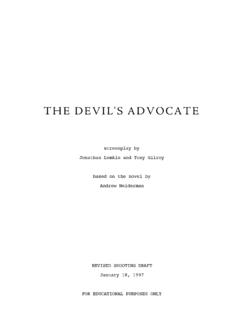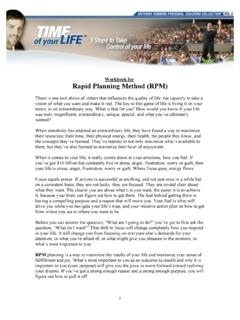Transcription of Applying the Good Lives and Self-Regulation …
1 Applying the Good Lives and Self-Regulation Models to Sex offender treatment : A Practical Guide for CliniciansPamela M. Yates, , PsychDavid Prescott, LICSWTony Ward, , DipClinPsycBrandon, VermontCopyright 2010 by the Safer Society Press, Brandon, VermontFirst EditionAll rights reserved. No part of this book may be reproduced in any form or by any electronic or mechanical means, including information storage and retrieval systems, without permission in writing from the publisher, except by a reviewer, who may quote brief in the United States of America10 9 8 7 6 5 4 3 2 1 Library of Congress Cataloging-in-Publication DataYates, Pamela the good Lives and Self-Regulation models to sex offender treatment : a practical guide for clini-cians / Pamela M.
2 Yates, David Prescott, Tony Ward. p. cm. Includes bibliographical references. ISBN 978-1-884444-87-61. Sex offenders--Rehabilitation. 2. Cognitive therapy. I. Prescott, David (David Francesca) II. Ward, Tony, 1954 Mar. 17- III. Title. 2010 83--dc22 Box 340 Brandon, Vermont (802) 247-3132 Safer Society Press is a program of the Safer Society Foundation, a 501(c)3 nonprofit dedicated to the prevention and treatment of sexual abuse. For more information, visit our Web site at the Good Lives and Self-Regulation Models to Sex offender treatment : A Practical Guide for Clinicians$45 plus shipping and handlingOrder # WP145 Contents3 Introduction.
3 IxPart I Foundations of Sexual offender TreatmentChapter 1: Fundamentals of Sexual offender treatment ..3 Chapter 2: Motivation and Effective Client Engagement ..23 Chapter 3: Fundamentals of the Good Lives , Self-Regulation , and Integrated Models ..37 Part II Assessment And treatment PlanningChapter 4: Assessment of the Components of Good Lives ..65 Chapter 5: Assessment of Self-Regulation Determination of Offense Pathway ..87 Chapter 6: Integrating Assessment ..105 Chapter 7: Developing a Case Formulation and treatment Plan ..125 Part III TreatmentChapter 8: treatment Using the Integrated Good Lives / Self-Regulation -Revised model .
4 149 Chapter 9: Offense Progression I: Personal History ..181 Chapter 10: Offense Progression II: Offense Disclosure ..195 Chapter 11: Self-Regulation Pathway treatment Methods ..221 Chapter 12: Developing an Integrated Good Lives / Self-Regulation Plan ..245 Part IV Post- treatment Follow-Up and Community ReintegrationChapter 13: Post- treatment Maintenance and Supervision ..277 About the Authors ..293 References ..295ixIntroduction 3 The aim of this book is to provide clinicians, parole and probation supervisors, and others involved in the treatment and supervision of sexual offenders with a working understanding of how to utilize the Good Lives and Self-Regulation -Revised models in practice.
5 Since their initial development, the Good Lives model (GLM) of offender reha-bilitation (Ward and Gannon, 2006; Ward and Stewart, 2003) and the Self-Regulation model (SRM) of the offense process (Ward and Hudson, 1998) have been combined into a comprehensive, integrated approach to the treatment and supervision of sexual offenders (Yates and Ward, 2008). The GLM approach is intended to augment and enhance inter-vention delivered within the framework of the Risk/Need/Responsivity model (Andrews and Bonta, 2007; Ward, Melser, and Yates, 2007) and using a cognitive- behavioral orien-tation, both of which have been found to be effective in reducing re-offending (Andrews and Bonta, 2007; Dowden and Andrews, 2000; Hanson, Bourgon, Helmus, and Hodgson, 2009; Hanson et al.)
6 , 2002; Hanson and Yates, 2004; L sel and Schmucker, 2005; Yates, 2002, 2003). treatment of sexual offenders has traditionally followed adaptations of the Relapse Prevention model (RPM) (Marques, Day, and Nelson, 1992; Pithers, 1990; 1991); how-ever, the RP approach is problematic when applied to sexual offenders, for numerous reasons (Hanson, 2006; Laws, 2003; Laws and Ward, 2006; Ward and Hudson, 1998; Yates, 2003, 2005, 2007; Yates and Kingston, 2005; Yates and Ward, 2007). As a result of problems with the RP approach, the Self-Regulation model (SRM), specifically devel-oped with sexual offenders, was proposed as an alternative approach (Ward and Hudson, 1998; Ward, Hudson, and Marshall, 1995).
7 Self-Regulation is a complex set of goal-setting and decision-making processes that direct action through the control and integration of cognition, affect, and behavior (Baumeister and Heatherton, 1996; Baumeister and Vohs, 2004; Karoly, 1993). As compared to the RPM, the SRM is better suited to address x Introductionthe heterogeneity of, and motivation for, sexual offending. For example, the SRM pro-poses four distinct pathways in the offense process, whereas the RPM elucidates only a single pathway to to the development of the SRM, the Good Lives model (GLM) was proposed as an overarching approach to the rehabilitation of offenders (Ward and Gannon, 2006; Ward and Stewart, 2003).
8 The GLM is based on the assumption that risk-based and avoidance-oriented approaches, such as the RNR and RP models, are necessary but insufficient to address the treatment of sexual offenders. Instead, the GLM proposes that sexual offenders, like all human beings, seek to attain important goals in life (termed primary human goods or primary goods), as part of an overall good Lives plan or roadmap to achieving a fulfilling and well-balanced life. What dif-fers with this clientele from non-offenders, however, is that sexual offenders often attempt to meet these personal needs via harmful behavior toward others.
9 That is, while their goals are important and valued, the problem lies in the means they use to obtain primary goods and to achieve their goals in life. In following the GLM, treat-ment is explicitly framed and presented to clients as a positive, approach-oriented activity designed to assist them to achieve a better life. treatment activities are con-ducted directly in service of this goal in addition to managing risk to Good Lives and Self-Regulation models have recently been integrated into a comprehensive approach to guide the treatment of sexual offenders (Ward, Yates, and Long, 2006; Yates and Ward, 2008).
10 This combined model explicitly addresses both the promotion of a good life and the management of risk. It is based on an understanding of the relationships between risk, sexual offending, and clients attempts to implement a good Lives plan. The GLM/SRM-R approach also includes assessment of primary and secondary goods, offense-related goals, strategies, and pathways, and their inter- relationships (Yates, Kingston, and Ward, 2009). The GLM/SRM-R utilizes the full range of cognitive-behavioral treatment methods in practice in order to maximize the effectiveness of intervention in assisting clients to manage risk and attain good book was designed for clinicians and community supervisors responsible for intervention with sexual offenders who are well versed, experienced, and trained in effective practices with sexual offenders ( , the RNR model and cognitive-behavioral treatment approaches, among others).
